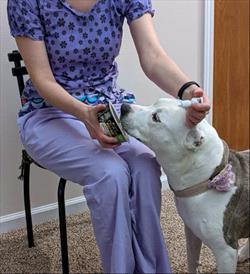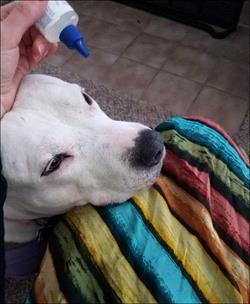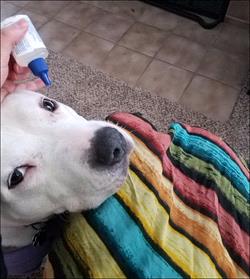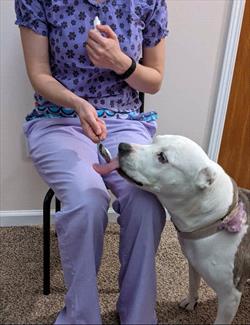M. Leanne Lilly, DVM,DACVB
EyeDrops1

Photo by M. Leanne Lilly
At some point in many dogs’ lives, they will require eye drops. This might be a one-time event to examine the eye or it may be multiple times per day to treat chronic disease. Regardless of the cause, applying eyedrops need not be a struggle for you or the pet, whether at home or in a clinic setting. The same approach works in both places.
Gather everything you need:
A comfortable place for you and the pet. For small pets this might be on a table, on a chair, or even on your lap if the pet is comfortable there. For large dogs, leave them on the floor.
Items for positive reinforcement and distraction: typically food, but a toy will work well for some pets. You may want or need something the pet can lick the food off (for example, a spoon with a dab of peanut butter).
The eye drops/medication to be given.
Eyedrops5

Photo by Corey Bodine
Get set up comfortably:
Avoid bending over or toward your pet, it is best to crouch to the side or behind the pet.
Keep your posture as upright as possible so there is no sense of urgency due to impending back/neck pain. If you are prepared to take your time, your pet won’t pick up on your anxiety cues.
Have the dog seated or standing, looking at you or at a right angle. Large dogs can rest their chin on your leg, or the edge of the couch or a chair to decrease downward motion. These are behaviors that can be taught; in a pinch, you can lure a dog to do them with some food.
Eyedrops3

Photo by M. Leanne Lilly
Giving the eye drops or ointment
Uncap the eye drop bottle or ointment tube.
Get the bottle in position near your pet’s eye. (The photo to the left shows how you want to be positioned.)
Hold the bottle or tube horizontally or tilted up so it is not dribbling on the pet.
Positioning your hand is typically least stressful when coming from underneath and behind the ear as if you are petting the dog.
Rest the outside/pinky edge of your hand on the dog’s head, behind their eyebrow. This should preferably be just outside of their peripheral vision. (See example to the left.)
If your dog is concerned about this positioning, do a few rounds of counter conditioning by moving your hand closer and closer to this position and feeding food just after hand placement so that your hand touching their head means food is coming.
You are most stable with your hand and wrist on the dog’s head, which requires placing the target eye away from you.
Eyedrops4

Photo by M. Leanne Lilly
Since you are slightly above the dog, make a kissy or smoochy noise, or say their name in a high-pitched happy tone to get them to look up. This opens their eyes wider for you.
Quickly drop in the drop/ ointment without touching the lid or the eye – gravity does most of the work for you.
Follow with food from your other hand or use it for the entire duration of the process if needed. There will be more head motion if the dog is eating while you attempt to drop in the drop/ointment, but your hand will move with their head.
If you need to put drops in both eyes, some dogs will allow you to shift immediately to the other eye. Some dogs need a short break, and you’ll need to repeat the process.
Eyedrops5

Photo by Corey Bodine